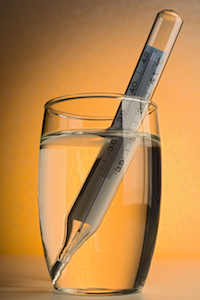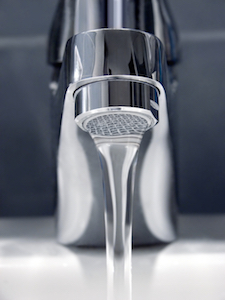August is Water Quality Month: How's Yours?


Safe drinking water is expected here in the US, however, recent incidents in several cities have many of us asking about our own city's water quality and how it impacts our health. If your metropolitan water quality is iffy, it can impact showers and laundry, house cleaning and, more importantly, cooking, cleaning fresh produce, and tea preparation.
According to Lu Yu, the waters from springs flowing clearly over granite or stone make the best tea, even more so than water which does not "move" like that in lakes or ponds. Those Chinese springs have changed since Yu published "The Classic of Tea, Origins & Rituals" in the 8th century. Fortunately, even in the 21st century, we still have many good sources of water from the tap. Yet millions of people purchase bottled water that mounts up over a year, and challenges our ecology with a surplus of disposed plastic bottles.
What is the best water source?
We believe there is an easier way: filtered home tap water. There are two tried-and-true ways to do it. One option is to attach a small filter appliance to the faucet to rid tap water of questionable pollutants. These are very economical, use safe charcoal filtering, and help provide delicious-tasting water. Replacement filters are modestly-priced and enable the home chef to use the best water not just for tea-making, but for cooking with water (rice or noodles, stews or soups,) plus cleaning fresh produce. These filters can ensure that you won't incidentally compromise the quality of the foods you prepare.
If you'd also like filtered water for all your water uses (clothes-washer, shower, garden hose, dishwasher) ask your plumber for recommendations for larger units. Otherwise, the smaller appliances available at any hardware or home appliance store will do. Best of all, no plastic bottles to clog our city dumps and pollute our oceans, and no heavy glass bottles to lift, or worse, break.
Another alternative small solution is a carbon-filtered reusable water pitcher. While they do come in plastic, the best units are free of BPA elements known to leach into the water. These pitcher filters clean water just like a commercial filter does. They're very economical and replacement filters are also moderately-priced. This modest price means you can keep one or two in the refrigerator and one on the counter if you prefer to drink room-temperature water. Adagio's graviTEA is an easy-peasy way to filter tap water at a reasonable cost.
How to heat the water You've checked the quality of your tap water, made a decision to use it as-is or filter, and now you're ready to brew some tea. Stick a cup of water in the microwave for a few seconds until hot, steep the leaves for five minutes, and you're done, right? No, no, a thousand times NO! If you're in that much of a hurry, prepare tea later. Tea, and you, are too important. Spend the time, attention, and care you both deserve.
Water can have "texture." Consider that feeling when it is flat, which can dispute flavors, or thick, which can give a much-desired, full-mouth feel that extends the pleasure of the tea's flavor. This texture is the result of what chemists call hydrogen bonding. Microwaving disturbs that bonding and can disrupt the water's mouthfeel, so avoid microwaved water for tea brewing. Use, instead, freshly drawn water heated on a flame or in an electric kettle. Please!
Equipment and temperature
The water heating vessel is important, too. Always heat the water in a clean, stainless steel or glass pot or kettle. Enameled kettles are okay, but watch out for spots of worn off enamel. Worn enamel can expose the metal or gather rust, both of which are sure to contaminate the flavor of your tea.
Boiling water is best for pu-erh; 205-212 degrees F is best for most blacks; 180-205 degrees F is good for a range of oolongs; and whites, yellows and greens are best brewed at much cooler temperatures of 165-185 degrees F. If you heat the water to boiling, but need a lower temperature, not to worry. Allow the water to cool in a clean porcelain or glass pitcher, then pour the cooled water over the tea and steep.
Steeping times vary, too, and it's always better to err with too short a time than too long. Steep a minute, taste, then continue brewing until the tea tastes right to your palate. You can always go by the vendor's suggestion for the first cup, then decide if you'd like it weaker or stronger when you make that tea again.
Lu Yu even had a guideline for how to tell when the water was the right temperature: "bubbles the size of small birds' eyes," with a bit of sound in the first boil is ideal for light teas, like whites, yellows, and greens. When the sound grows like an active spring and the bubbles look more "like a string of pearls," this is ideal for dark oolongs. If the water swells slightly like "miniature waves," it is perfect for most blacks and pu-erhs. Rapid, roiling boil should be avoided, as it flattens the taste of the water. Adagio's glass kettle makes gauging the bubbles fun!
If Lu Yu's directions are too poetic, or vague, try Adagio's utiliTEA, a variable heat-gauge tea kettle. It heats to an exact range of temperatures, and takes out all the guess work.
P.S. Filtered or spring waters offer good taste AND greatly reduces potential lime buildup in a stainless-steel kettle.
P.P.S. Your local metropolitan water or utility company can provide you with a current analysis of water purity on its web site or in its annual reports. It's your right to access this information, so do check!
